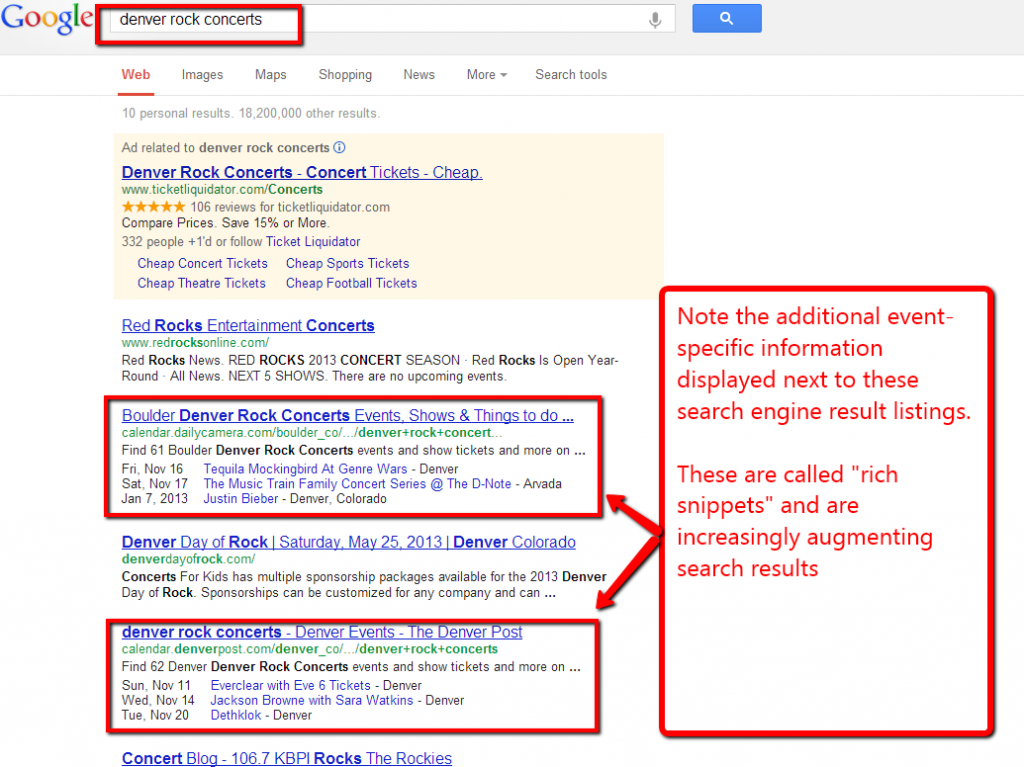In the first part of this series we discussed the basics of structured data and how it applies to the Internet. We also introduced www.schema.org, which represents a collaboration of Google, Yahoo, and Bing to set standards for structured data and make it accessible to webmasters. We ended by dangling the topic of rich snippets before you. Now’s the time to start bringing it together.
Taking A look at Rich Snippets
Let’s take a look first at this whole field of “rich snippets.” Easier than describing it is to illustrate it, as the next screenshot does:
The value to the searcher of these rich snippets is obvious immediately. Because they increase the clarity of what the search result offers, they also increase the chances that the searcher will find what they need, or avoid results that have no interest for them. Unless you’re interested in tricking searchers into visiting your site and downloading some malware, or clicking on your frivolous Adsense ad so you can earn a few dimes on their mistakes, this is a good deal. Since I’m sure none of my readers belong in those spammy categories, we’ll proceed on the assumption that you agree with me that this is a good deal for search.
Here are just a couple of other examples of where rich snippets are commonly showing up in search results:
Movies – Rich snippets include things like reviews, cast, genre, duration, score, and more (see detailed specs at http://schema.org/Movie).
Ecommerce – Showing information like reviews, pricing, condition, sku’s (see detailed specs at http://schema.org/Product)
We could go on, but this gives you a basic idea. There are a lot of categories covered by the standards at schema.org (you can view them here: http://schema.org/Thing), but you’ll notice that some are commonly shown in search results while others haven’t really made it into prime time yet.
Why You Need to Pay Attention to Rich Snippets
Regardless of whether you think that the whole discussion of structured data, schema and rich snippets is valid, you really need to pay attention.
The reason should be obvious by now. For those SERPs where rich snippets are starting to show up, the listings that display them occupy more screen space, attract more visual attention, and assuming that the search results are relevant to what the searcher is looking for, they will increase both click through rates and conversions.
As an SEO consultant, I’m very interested in all of those advantages. I know that success in search engine marketing is not just about hitting those results pages, but also in getting a real live human being to be interested enough in my listing to click through and visit my page. I also am realistic enough to know that if the visitor isn’t really interested in what they find they do me (or my client) no good whatsoever.
But there’s an additional reason, entirely speculative on my part, that I’m interested in chasing the structured data trend: I believe that webmasters who take the time to start using structured data according to the standards endorsed by the big three search engines signal to the search engine gods that your site is friendly to their interests as well as your own. My assumption is that this, in the long run, will increase the durability of your pages in search results.
So now that you know what rich snippets are and what they look like in search results, I’m going to leave you hanging until part 3 of this series to show you how to build the “structure” you need in your “data” to allow them to start going to work for you. Continue to Part 3: Implementing Rich Snippets





